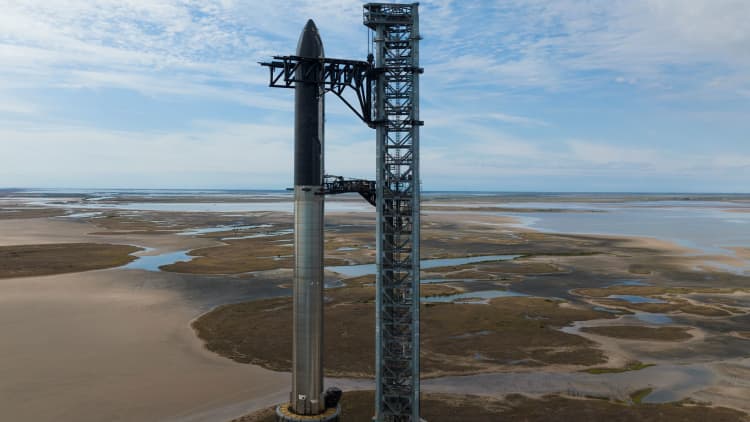
The moon seen from the International Space Station on July 9, 2018.
Alexander Gerst | NASA
WASHINGTON — Jeff Bezos has his NASA moon ticket.
The billionaire’s space company, Blue Origin, won a key contract from the National Aeronautics and Space Administration on Friday to develop a crewed lunar lander for delivering astronauts to the moon’s surface later this decade under the agency’s Artemis program.
The effort is effectively a more than $7 billion project. NASA’s contract award is worth just over $3.4 billion, officials said Friday, and Blue Origin Vice President John Couluris said the company will contribute “well north” of the contract’s value as well.
“We’re making an additional investment in the infrastructure that will pave the way to land the first humans on Mars,” NASA Administrator Bill Nelson said in announcing the Blue Origin award. “Our shared ambitions now are no less lofty than when President [John F.] Kennedy dared a generation of dreamers to journey to the moon.”
An artist’s rendering of the lunar lander.
Blue Origin
Bezos said in a tweet Friday he’s “honored to be on this journey with @NASA to land astronauts on the Moon — this time to stay.”
The Blue Origin-led team — which includes Lockheed Martin, Boeing, Draper, Astrobotic and Honeybee Robotics — topped the proposal of a team led by Leidos-owned Dynetics.
Leidos, in a statement to CNBC, said that “helping NASA with the inspiring efforts to return to the Moon will remain a priority.” The company highlighted its existing and ongoing work on NASA systems and said the team is “committed to continuing to assist on these critical missions.”
NASA received two additional proposals for the SLD contract but neither was considered “fully compliant with solicitation requirements” and so were quickly discounted, Jim Free, NASA associate administrator for the agency’s exploration division, wrote in documents released Friday.
Known as the Sustaining Lunar Development, or SLD, program, the competition was essentially a second-chance contest that NASA organized after Elon Musk‘s SpaceX was the sole winner of the first crew lander contract in 2021.
That first program, called the Human Landing System, or HLS, gave SpaceX a contract to develop a variation of its Starship rocket for Artemis missions. Prior to the HLS award, NASA was expected to choose two winners, but the agency’s budget at the time and SpaceX’s more-affordable bid resulted in there being a single winner.
Both HLS and SLD are part of NASA’s Artemis program to land astronauts on the moon, with the agency hoping to start flying crews to the lunar surface within the next few years. In December, NASA completed the first Artemis mission, which had no people on board, flying its Space Launch System, or SLS, rocket and Orion spacecraft around the moon for the first time.
Free, in explaining NASA’s selection, wrote that Blue Origin’s plan featured “compelling” strengths such as two uncrewed pathfinder missions in 2024 and 2025, early-stage technology maturation, excess capabilities of the lander itself, and a “reasonable and balance” price. He mentioned just two weaknesses in Blue Origin’s bid, noting an issue with its plan for communications during flights as well as “numerous conflicts and omissions” in the company’s schedule.
Regarding Dynetics, the strengths highlighted by Free were not enough to outweigh parts of its plan that were “uncertain” and “unclear,” he said. The company’s price point, which NASA did not disclose, was also “substantially higher in amount” than Blue Origin, Free wrote.
A messy saga
Elon Musk, founder of SpaceX, left, and Amazon and Blue Origin founder Jeff Bezos.
Getty Images
Competition with Starship

Last year, Nelson explained the reasoning behind a second bidding process to add another privately built lunar lander, saying, “Competition is critical to our success.”
“We can leverage that money by working with a commercial industry and, through competition, bring those costs down to NASA,” Nelson said during Senate testimony in 2022.
SpaceX has continued to develop its nearly 400-foot-tall Starship rocket in the meantime. The company in April attempted to reach space with the vehicle for the first time but it exploded in midflight. Recently, Musk estimated that SpaceX will spend about $2 billion on Starship development this year and said he expects the company to reach orbit around the Earth with its next launch.
Last year, NASA gave SpaceX an additional $1.15 billion award under the HLS contract, exercising an option to buy a second crewed demonstration landing from the company. That brought the total value of SpaceX’s HLS contract up to $4.2 billion through 2027.
To date, NASA has paid out about $1.8 billion to SpaceX under HLS, according to federal records.
